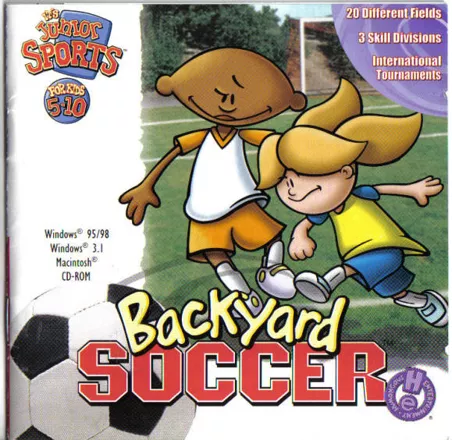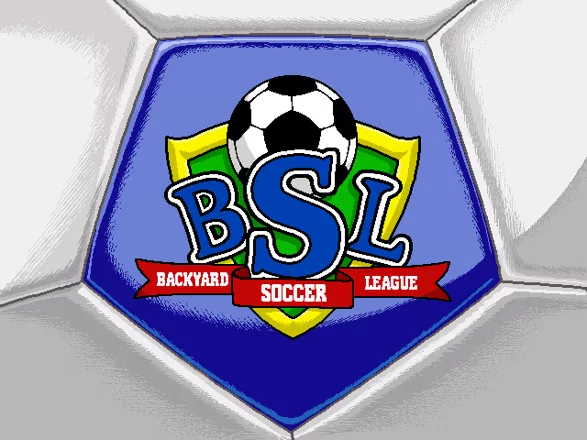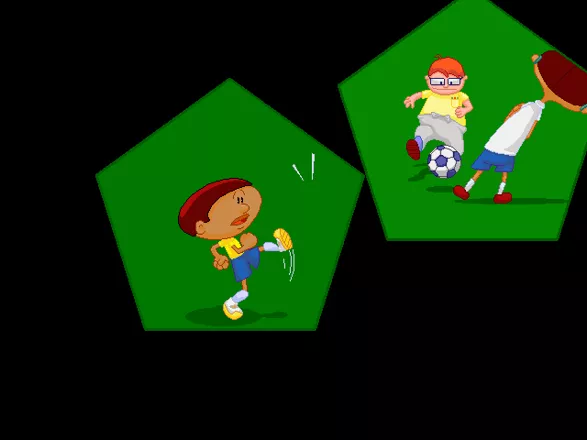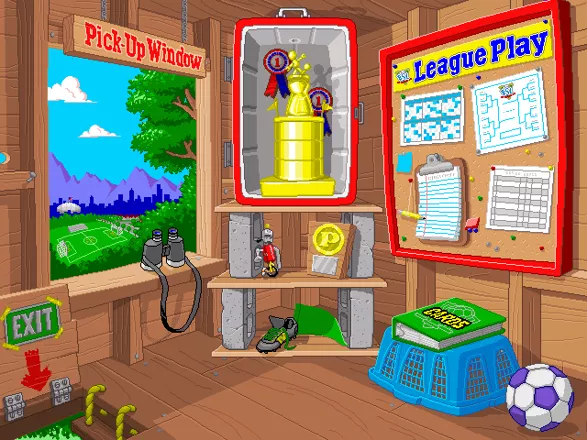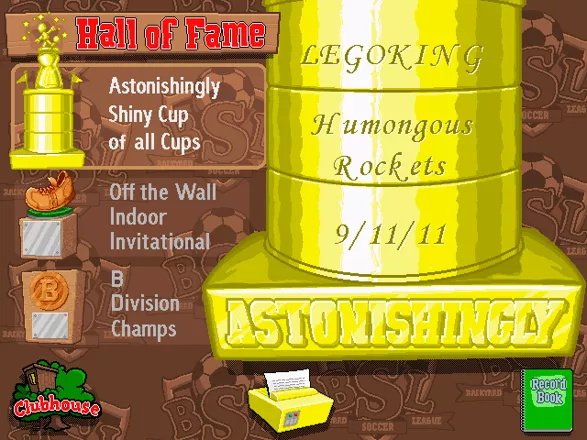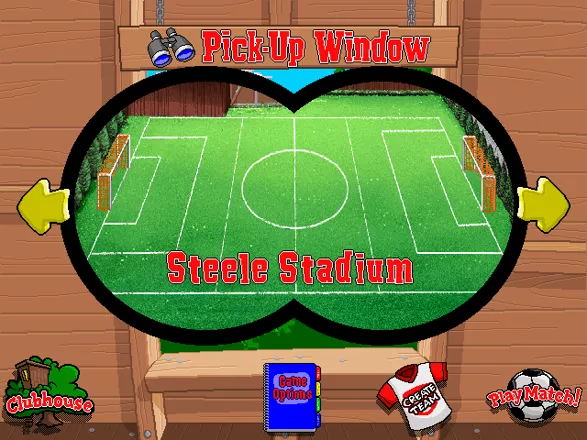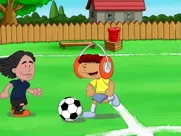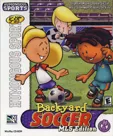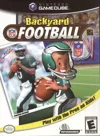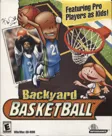Backyard Soccer
-
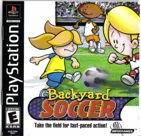 Backyard Soccer
(2001 on
PlayStation)
Backyard Soccer
(2001 on
PlayStation)
Description official description
Backyard Soccer is the first game in the Backyard Sports Soccer series. Gameplay is simple: there are 30 kids to pick on a team, and many custom color teams to create. You also get to be in two game types: Single in which you play one small game and Season play, in which you play for a whole a lot of time and features you playing against some unusable custom teams. This game also includes a practice mode to help you get used to the kicking in the game, and also shows what it is like during a penalty. All rules to soccer including fouls and hat tricks, are included in the game. When picking the kids on your team you will want to read about how good they are - don't just pick a kid cause they look cool.
Groups +
Screenshots
Credits (Windows 3.x version)
66 People · View all
| Interactive Game Design | |
| Project Lead - Art | |
| Project Leads - Programming | |
| Project Coordinators | |
| Programming | |
| Menu Art | |
| On Field Animation Lead | |
| On Field Animators | |
| Character Animation | |
| [ full credits ] | |
Reviews
Critics
Average score: 76% (based on 5 ratings)
Players
Average score: 2.8 out of 5 (based on 6 ratings with 1 reviews)
The Good
It's hard to imagine in retrospect, but when the original Backyard Baseball made its debut, it initially didn't perform well at all. Some employees already thought it was best to cut their losses and write the game off as a failed experiment, but co-founder Ron Gilbert refused to give up, believing that the series may do better if they produce some more games to increase its overall visibility. He proved to be right on the mark, as the release of this game would indeed turn things around and mark the beginning of the series' journey towards its eventual status as the company's biggest cash cow. With the game having made such an important contribution to the series, you might expect it to be a real standout title, but that unfortunately isn't the case at all, as I'll get into in a moment.
It's not all bad, though. While I may not think much of the content of this package, its wrapping is once again quite nice. The game has the same charming cast of characters as last time, but with entirely new dialog that's once again a lot of fun to listen to.
And their stats are once again unbalanced, but in a different way than last time, with some of them being significantly better or weaker than before. It makes sense, since you wouldn't expect real children to have the same level of skill in every sport. As a result, this game gives the spotlight to different characters. For example, Pablo Sanchez is often seen by fans as a complete badass who excels at almost everything. He absolutely lived up to that reputation in Backyard Baseball, where his insane stats easily made him the best player. But he's actually more reasonably balanced here. His high speed still makes him a pretty good player, but he's too unreliable at scoring goals to be considered one of the best. Conversely, Ricky Johnson was a player I only ever picked reluctantly after running out of the good ones in Backyard Baseball, since he had poor home run potential and wasn't good enough at anything else to make up for it. But here, his remarkably accurate goal shots combined with his fairly good speed make him a force to be reckoned with.
Furthermore, the game's designers did actually take a few steps to give League Play some much-needed variety. This time, it consists of three divisions. You start in the B Division where you face off against the same generic teams as usual, but if you end the season as one of the two highest-ranking teams, you'll move up a division for the next season, where you'll face teams with unique logos and names. Backyard Baseball had a few of those for the end game, but this game goes a lot further.
This mode still doesn't make use of the standard fields you'll find elsewhere, but each division now has its own selection of either two or three fields. This idea isn't taken to its full potential, as these fields have very little variety in surfaces, something that not only gives the standard fields a more diverse aesthetic, but also affects the player speed and ball physics. But considering Backyard Baseball's League Play just sent you to Parks Department Field Number 2 over and over again, this is at least a step in the right direction.
And you don't just engage in endless seasonal matches until the end game this time. As long as you're one of the division's top four teams halfway through a season, you're given the option to put the current season on hold and participate in a three match tournament along with your top three seasonal competitors and four special teams. It's here that things get a bit more creative, with all matches taking place on a field surrounded by walls, which results in more chaotic matches in which the ball rarely goes out of play.
And if you manage to become champion of the Premier Division, you get invited to a special tournament in which you face off against a large selection of much stronger foreign teams. The national stereotypes represented by their names and logos as well as the foreign names of their players really help to give this a more international feel, even if you'll only face some of them, with the rest being eliminated by other teams along the way.
The Bad
But despite these welcome improvements, I still can't say I had much fun with League Play overall. While a lot of that can be blamed on the core gameplay, which I'll get to in a moment, the changes made to its structure simply aren't enough to keep things fresh. It once again has a very long duration. While individual matches don't last nearly as long as in Backyard Baseball, there are far more of them here. Admittedly, I made things worse for myself by increasing the match duration in the setup, as the other option seemed too short for stamina management strategies to really come into play. But regardless of their duration, the sheer number of matches in this mode is just too much.
However, the real problems lie with the gameplay itself. Before I get started on this, I should mention that the game offers a number of different control options. I personally went for the two button control scheme with automatic defender switching. Since it gave me a lot of trouble, I did experiment with the other options a bit, but quickly concluded that I struggled even more with them. Perhaps I could have gotten used to them with more patience and had a better time, but for the time being, keep in mind that my review only covers my experience with one control scheme. I may take a more in-depth look at another one when I get around to Backyard Soccer MLS Edition, but I'm not optimistic that it would offer a significantly better experience.
At any rate, my experience with this scheme was not positive at all. From what I can gather, the game always seems to internally assign the ball to a certain player who is currently considered its owner. That person is the only player who can dribble or kick it. Their teammates seem unable to interact with it at all unless its owner makes a pass and transfers its ownership to them, while opponents, unless they manage to block it when kicked, have to steal it in order to become its new owner.
In order to make your players interact with the ball, you have to issue left or right clicks. But those give entirely different orders depending on which team currently owns the ball. For example, a left click on the ball while it's in your team's possession will make its owner run towards it in order to dribble. But if an opponent has the ball, a left click will instead tell your closest player to keep their distance from it, presumably to prepare for blocking its owner. Conversely, a right click on a ball in your team's possession will tell its owner to kick it ahead, while a right click on a ball owned by an opponent will instruct a nearby player to try stealing it. As a result of this, you will often find yourself in a situation where you have to swap your mouse button depending on which team owns the ball.
Where this system completely falls apart is when it's unclear who the game even considers the ball's current owner to be. For example, let's say you find the ball lying around with no player in its immediate vicinity, but the closest player is one of your own. Clearly, you want that player to head there and dribble it towards the opponents' goal. So you start left-clicking it. That player is indeed considered the ball's owner at first and heads towards it. But suddenly, the game decides that an opponent now owns the ball despite their greater distance. So now, you just accidentally ordered your player to retreat and surrender the ball to said opponent. What you were supposed to do is issue right clicks instead so that your player steals it. They'll probably end up tackling the air in the process, yet still succeed in magically knocking down their distant opponent and become the ball's new owner. But this isn't a reliable solution either. Let's say you anticipate this scenario and send your player to the ball with right clicks. Only this time, they never lose ownership over the ball, so instead of stealing it, your right clicks order them to kick it ahead, which probably causes it to either go out of play or fall into the opponents' hands. In other words, what your players do here is a complete gamble whose results depend on the game's whims.
And this was only one of many examples of scenarios in which this system goes wrong. Here's another one. Let's say one of your players is currently dribbling the ball, but they're clearly not the best choice for it, as they're completely exhausted and can't keep up. Luckily, a faster teammate is running just ahead of them, with the ball rolling right next to them. So the logical choice would be for this player to take over, but it's not that simple. Because the ball is owned by a teammate, they can't touch it through left clicks, while right clicks can't order them to steal it either. In order to transfer ownership directly to them, said teammate would first have to catch up to the ball and make a pass to them, wasting valuable time in the process, especially since players usually need a second to take control after receiving a pass. They can't just seamlessly take over.
How about a third example? When an attempt to score a goal doesn't work out and turns into a battle for control over the ball, you probably won't win. Players can only try kicking the ball into the goal while they own it, so in order to do that, you first need to spam right clicks on the ball until one of your players successfully steals it, then right-click on the goal in order to make them shoot it there. But there's a bit of a delay between stealing and kicking the ball. In all likelihood, your player won't be able to retain ownership over the ball long enough to make the shot, since lots of opponents are nearby and eager to steal it. As a result, these battles usually just result in multiple players repeatedly stealing the ball from each other. And the opponents have far better chances of succeeding in the end, since they always know who owns the ball and therefore never get confused which action they need to take at the moment.
However, situations like this where the AI is actually smarter than the player aren't the norm. In most scenarios, it's far dumber. It certainly has an interest in gaining control over the ball, but seems to have no idea what to actually do with it. The opponents will often just make needless passes between each other instead of actually going on the offensive. When looking at post match statistics, it really stuck out how often my goalie had literally no saves or allowed goals recorded, while the opposing one had lots of both.
In general, my own goalie saw remarkably little action. I have no idea how you're supposed to issue direct commands to them, as they usually just ignore my clicks entirely. And their AI is really passive, so they're of relatively little help in stopping goal shots on the rare occasions that they actually occur. When the ball approached my goal, it was usually up to my defender to save the day, since I had actual control over them. And when they failed, I often still got lucky anyway, with the opponent wasting this valuable opportunity for a goal shot to instead pointlessly pass the ball to a less well-positioned player, giving me more opportunities to steal it.
And the AI doesn't just struggle at offense, but also at defense. While it certainly can retake the ball after a failed goal shot, as I explained earlier, it's not very smart when it comes to preventing goal shots from happening in the first place. Once a reasonably fast player on your team has the ball and the closest opponent is behind them, there's not much it can do to stop them. All it will really do is have that one opponent chase after the player, but as long as said player has enough speed, the opponent won't catch up. Normally, you'd expect other opponents to join in from the front and try to pin the player down, but they'll often just watch from the sidelines. To be fair, the same thing will happen to you in the opposite scenario if you just spam right clicks on the ball with my specific control scheme, which always issues steal orders to the player closest to the ball, but you can help out by directing another player with left clicks until they're closer, then use right clicks to make them engage from the front. But the AI doesn't comprehend this strategy, which results in its defense consistently falling apart.
It doesn't help that its goalie is just as dumb as your own and often won't take the right position to block an upcoming shot. In a real match of soccer, you often find multiple players going on the offensive together and passing the ball between each other to bypass opponents, but while the game mechanics do allow for such maneuvers (teammates will try to follow you to back you up, and contrary to normal passes, a pass followed by a goal shot occurs without delay), they're rarely needed, with most of my goals having been the work of just one player bypassing the entire opposing team.
As a result of these things, despite all the struggles I had with the controls, I usually still wound up crushing my opponents with little resistance. And I was playing on the highest difficulty level. It was only during the end game that things finally got somewhat challenging, with the opponents having such high stats that they managed to put up a fight in spite of their questionable AI. I actually lost a match once and had to reset the game (yes, it was cheating, but I was not about to repeat an entire season just to get one more shot at this). But even then, the challenge was only temporary. Once I got used to the opponents having the ability to actually outrun my players, the tides turned again and I wound up winning the final match 12-0.
Powerups are once again a thing here, but their role isn't very significant. I'm not quite sure what causes them to be awarded. All the help file says is that it happens when your team performs well. From my experience, they seem to appear as a result of goal shots, which might explain why my opponents literally never managed to use one. At any rate, once you have one, it'll stay in your team's possession for a short while and kick into action whenever you perform a goal shot at a reasonably close distance. In terms of functionality, there's not much variety to them, with all of them simply amounting to goal shots that have a gimmick to them that helps them bypass opponents. All that really sets them apart is their effectiveness, with Bowling Ball easily being the best (thanks to eliminating any possibility of overshooting the goal and being able to bypass two opponents without fail) and Cannonball arguably the worst (due to being the only powerup with a significant risk of overshooting the goal). Overall, they don't really have a significant impact on the game, and it's easy to forget about their existence.
Pretty much the only aspect of the game that I found even remotely strategic is stamina. Unlike Backyard Baseball, teams here have two substitute players who can be switched in at any time. And it is indeed advisable to make frequent use of substitutions, as players who see a lot of action can tire out quickly and become far less viable for a while. There are some interesting strategic decisions to be made when it comes to estimating how long you expect your players to last and deciding who should take their place. Though this is hindered somewhat by the absence of any sort of stamina meter. Backyard Baseball only disclosed the stamina of your current pitcher, but they were also the only player whose stamina held great strategic value. With no way to view their stamina at all, you need to keep an eye on your players during gameplay and see how fast they run to estimate their current condition. When you don't pay enough attention to that, you can sometimes be in for a rude awakening when that player you just sent to the front turns out to be just as worn out as the one whose place they took.
On top of that, I once again ran into some notable bugs. There was one occasion where the game crashed every time I opened the strategy menu in League Play. I was worried I'd managed to corrupt my save file, but it thankfully stopped happening after I watched the introduction for the next match. On another occasion, a physics bug screwed me out of a goal I was about to score with the Undergrounder powerup, due to the ball suddenly teleporting over the goal as it popped out of the earth. But the weirdest thing that happened to me was when the opposing goalie picked up the ball and simply refused to let go. There's no way to steal the ball in that state, so I couldn't do anything to get it out of his hands. I even tried to have my players run into other opponents in the hope of causing a foul, but it seems that fouls can't occur in this state. So I just had to wait there for several minutes until half time. During the second half of the match, I then encountered a situation where the goalie walked straight to the ball, then just halted and stopped doing anything for multiple seconds, allowing one of my players to catch up and kick it in the goal.
Graphically, the game retains the same excellent art style and UI design as last time. I still find Backyard Baseball to be visually superior however because this game makes a lot more use of a distant perspective in which the great character designs don't really shine.
The soundtrack is almost entirely carried over from Backyard Baseball, with the same decent, but unspectacular character themes. Though they play less frequently here, since characters don't make their entrance in soccer the way they do in baseball, so they only play when they score a goal. Even that doesn't always work right, as a bug sometimes causes them to stop after a second. Although on the plus side, pretty much every character can at least sporadically score goals as long as you don't make them your goalie, whereas Backyard Baseball had a fair amount of characters with whom you shouldn't even try to get a home run. So you can actually hear the extended themes of every character on your team except the goalie. One addition to the soundtrack is a different credits theme, which sounds quite nice, but most people probably won't have the patience to ever hear it.
Finally, if there's one thing I don't like about the characters, it's that I don't find Earl Grey to be nearly as fun of a color commentator as Vinnie the Gooch. All there really is to him is that he calmly comments on the current turns of events and occasionally engages in some stereotypically British behavior. There's nothing annoying about him, but he simply isn't funny.
The Bottom Line
While I realize that my review of Backyard Baseball was also pretty harsh in tone, my criticism of it was largely aimed at various details not working as well as they should have. At its very core, the gameplay did show some promise and had strategic depth. Which is more than I can say for Backyard Soccer. With so much of its core gameplay revolving around its strange and often nonsensical ideas about ball ownership, and the complete ineptitude of its AI, this game just isn't fun at all. It may have welcome improvements to League Play and retain the same excellent cast of characters, but there's only so much those can do when the game beneath them is a confusing, inelegant mess. I simply can't recommend the game even with reservations, and I can only hope that future installments of the series aren't like this.
Windows · by SomeRandomHEFan (164) · 2022
Analytics
Upgrade to MobyPro to view research rankings!
Related Sites +
-
Wikipedia: Backyard Soccer
Information about Backyard Soccer at Wikipedia
Identifiers +
Contribute
Are you familiar with this game? Help document and preserve this entry in video game history! If your contribution is approved, you will earn points and be credited as a contributor.
Contributors to this Entry
Game added by Andrew Shepard.
Additional contributors: DreinIX.
Game added May 15, 2005. Last modified February 22, 2023.
